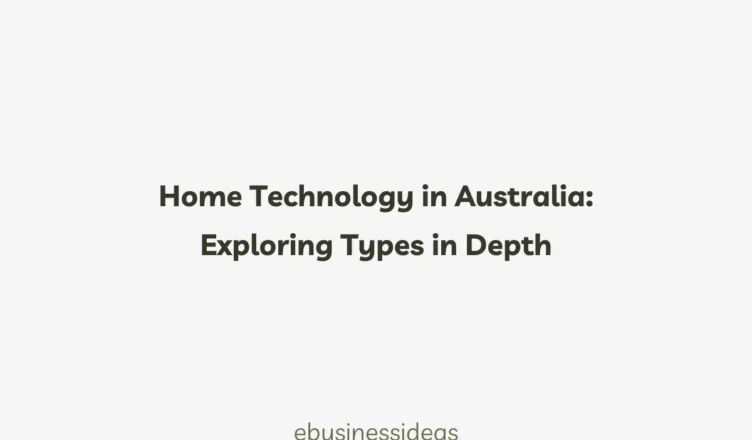In the ever-evolving landscape of modern living, the integration of technology into our homes has become increasingly prevalent. Home technology, also known as smart home technology, refers to the use of devices and systems that automate and enhance various aspects of household management. From controlling lighting and temperature to monitoring security and entertainment, the possibilities are endless. In Australia, the adoption of home technology in Australia has been on the rise, transforming the way Australians live, work, and interact with their living spaces.
Types of Home Technology in Australia
Smart Home Systems
Smart home systems encompass a wide range of devices and technologies designed to automate and optimize various functions within the home. These systems often rely on interconnected devices that can be controlled remotely via smartphone apps or voice commands. Examples include smart thermostats, lighting systems, and virtual assistants like Amazon Alexa or Google Assistant. While the convenience and efficiency of smart home systems are undeniable, concerns about privacy and cybersecurity remain prevalent.
Entertainment Systems
Entertainment systems play a central role in many Australian households, providing access to a plethora of digital content and immersive experiences. From high-definition televisions and surround sound speakers to gaming consoles and streaming devices, there’s no shortage of options to cater to every preference. With the advent of streaming services like Netflix and Spotify, consumers now have unprecedented access to on-demand entertainment, revolutionizing the way we consume media.
Security Systems
Security systems are essential for safeguarding homes and protecting loved ones from potential threats. In Australia, advancements in security technology have led to the widespread adoption of surveillance cameras, alarm systems, and smart locks. These systems offer peace of mind by allowing homeowners to monitor their property remotely and receive instant alerts in the event of suspicious activity. However, concerns about privacy and data security have prompted calls for stricter regulations governing the use of surveillance technology.
Energy Management Systems
With the growing emphasis on sustainability and energy efficiency, energy management systems have become increasingly popular in Australian homes. These systems help homeowners reduce their carbon footprint and lower their utility bills by optimizing energy usage and harnessing renewable energy sources like solar power. Smart thermostats, energy monitoring devices, and solar panels are just a few examples of the technologies available to help households minimize their environmental impact.
Certainly! Here’s the section on Health and Wellness Systems, Integration and Connectivity, and Future Trends in the context of home technology in Australia:
Health and Wellness Systems
In today’s fast-paced world, prioritizing personal health and well-being has become essential, and integrating health and wellness systems into our homes has gained significant momentum. These systems encompass a wide range of technologies designed to support and enhance our health journey right from the comfort of our homes.
Smart Appliances
From intelligent kitchen gadgets to smart refrigerators, technology is revolutionizing how we approach healthy eating habits. Smart appliances can assist in meal planning, and ingredient tracking, and even suggest healthy recipes based on dietary preferences and nutritional needs.
Fitness Equipment
Home gyms equipped with smart fitness equipment offer the convenience of personalized workouts without the need for a gym membership. These devices can track your activity levels, monitor your progress, and provide real-time feedback to help you achieve your fitness goals effectively.
Air Quality Monitors
Poor indoor air quality can have a significant impact on our health, leading to respiratory issues and allergies. Advanced air quality monitors can detect pollutants, allergens, and other harmful particles in the air, allowing homeowners to take proactive steps to improve indoor air quality and create a healthier living environment for their families.
Integration and Connectivity
One of the primary challenges facing the home technology industry is ensuring seamless integration and connectivity among various devices and systems. With a multitude of manufacturers entering the market and developing proprietary technologies, compatibility issues often arise, making it challenging for consumers to create cohesive smart home ecosystems.
Efforts are underway to establish industry standards and protocols that promote interoperability and streamline the user experience. Open-source platforms and protocols like Zigbee and Z-Wave are gaining traction, allowing devices from different manufacturers to communicate and work together seamlessly. Additionally, initiatives like Project CHIP (Connected Home over IP) aim to create a unified standard for smart home devices, ensuring compatibility and ease of use for consumers.
Future Trends
Looking ahead, the future of home technology in Australia holds immense promise, driven by ongoing advancements in artificial intelligence, machine learning, and the Internet of Things (IoT). These technologies will continue to reshape the way we interact with our homes, making them more intelligent, intuitive, and responsive to our needs.
Personalized home experiences tailored to individual preferences will become increasingly common, as smart homes evolve to anticipate and adapt to the needs of their occupants. Artificial intelligence algorithms will analyze data from various sensors and devices to optimize energy usage, enhance security, and provide personalized recommendations for improving health and well-being.
However, as technology continues to permeate every aspect of our lives, it’s crucial to consider the ethical implications and ensure that innovation is guided by principles of privacy, security, and sustainability. Striking a balance between technological advancement and ethical responsibility will be paramount in shaping the future of home technology in Australia and beyond.
Conclusion
In conclusion, home technology has become an integral part of modern living in Australia, offering unparalleled convenience, comfort, and security. From smart home systems and entertainment solutions to energy management and health monitoring, the possibilities are endless. As technology continues to evolve, so too will the ways in which we interact with our living spaces, shaping the future of home design and lifestyle for generations to come.
